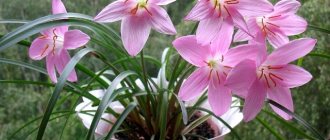Tillandsia anita is a decorative hybrid of blue Tillandsia; in natural conditions it grows not in soil, but on trees, receiving all the necessary substances from the air, rainwater and wood itself. Flat, wide inflorescences are attached to short peduncles and consist of pink or purple bracts, on which bright blue flowers open in turn. Flowering lasts a short time, but the bracts retain their decorative effect for a long time, until they become light green.
Description and photo
Tillandsia Anita - this decorative compact species has a dense rosette of gray-green leaves. The narrow and long foliage is only partially covered with scales. During the flowering period, a short, obovate, pink inflorescence is formed. Lilac or purple flowers bloom on it one by one, starting from the bottom. Under natural conditions, the plant receives moisture and nutrients from:
- dew;
- rain;
- fog;
- organic matter residues;
- dust settling on the leaves.
It is especially popular due to its increased decorative effect. In the center of a rosette formed from narrow leaves, surrounded by pinkish bracts, there is a blue flower. Although it fades quickly, the bracts retain their bright color for a long time, and then begin to turn green.
- Tillandsia Blue belongs to the herbaceous species and is cultivated as a potted crop.
- It has narrow, sharp leaves, reaching a length of 25-30 cm and collected in a dense rosette.
- The leaf blade is green, but at the very base it is reddish-brown and has longitudinal brown stripes over its entire surface.
- The peduncle appears once in the life of this plant. It grows from the middle of the rosette in summer and resembles a large flat spike, in which the bracts of pink-lilac colors are arranged alternately and overlap each other. The height of the peduncle ranges from 8 to 16 cm, the width is about 7 cm.
- Flowers of blue or light blue shades with 3 petals bent downwards bloom for only a short time, usually no more than a day. But there are many of them and they open one by one, creating the appearance of a blooming wave.
- Flowering is long lasting, lasting about 2 months.
Tillandsia Anita is a hybrid of the Blue Tillandsia and is very similar to it. It is distinguished by scaly leaves that have a pronounced gray tint. It was awarded to Anita by Tillandsia atmospherica, which was used in the process of breeding the variety.
When and how does it bloom
In order for the plant to bloom luxuriantly and profusely, it must be properly cared for. Thanks to this, the crop will retain its decorative properties. A characteristic feature of the plant is its flat inflorescence. It has a spike-shaped shape and is located on a small peduncle.
The bud includes flowers of a rich blue hue. Its structure also includes bright pink bracts. They overlap each other. The flowers fade quickly enough, and the spike with bracts lasts quite a long time. After flowering ends, shoots form in the leaf axils. The mother socket dies.
Kinds
Let's look at the most popular types of tillandsia with photos.
Blue (Tillandsia cyanea)
Blue Tillandsia (Tillandsia cyanea)
Blue Tillandsia (Cyanea) is the most popular flower for home care. It forms a bizarre rosette of grass-like leaves, the color of which varies from a reddish base to brown-striped plates. The height of the rosette reaches 30 cm. In summer, a flat spike with dense bracts, arranged in a bizarre pattern, grows from the center of the rosette. The fantastic coloring and shape of the bracts seem artificial. Blue or light blue flowers with rhombic petals bent to the sides bloom gradually, as if a wave rolls along the ear from its top to the base. The bracts are painted in bright lilac or pink tones.
This may be interesting: Tabernemontana - home care
Tillandsia lindenii
Tillandsia Lindena is similar to blue Tillandsia, but more graceful and beautiful. Its spike is more rounded, not so dense, and the bracts are only soft pink or reddish in color. The flowers of this tillandsia are also bright blue, three-petaled. The leaves are thinner and collected in relatively loose rosettes.
Tillandsia dyeriana
Tillandsia duera
The inflorescence of Tillandsia Duera resembles the yellow autumn leaf of an acacia tree. Elegant, very beautiful plant. It develops in the form of a rosette of tongue-shaped, flat and long leaves, tightly arranged, as if wrapped, around the base of the peduncle. In the center of the rosette, on a thin short peduncle, a symmetrical inflorescence grows with loose, double-rowed leaf-shaped oval bracts of orange or red shades.
Tillandsia Anita
Tillandsia Anita is an ornamental hybrid of blue Tillandsia. It is also popular for home care. Its dense rosette consists of narrow scaly leaves with pointed ends. Flat, wide inflorescences are attached to short peduncles and consist of pink or purple bracts, on which bright blue flowers open in turn. Flowering lasts a short time, but the bracts retain their decorative effect for a long time, until they become light green.
Tillandsia tricolor
Tillandsia tricolor
Another species is Tillandsia tricolor. Its linear, long (up to twenty cm), narrow (no more than 1 cm) scaly green leaves form a dense rosette. Peduncles are thin, long and erect. Inflorescences in the form of a spike can be both simple and complex (several ears). The ears consist of leathery, oval-shaped stipules, which have sepals, like a traffic light, in three colors: at the bottom they are bright red, in the middle they are light yellow, and at the very top they are green. In summer, large flowers bloom, the petals of which grow up to 7 cm in length and are colored purple.
Tillandsia Flabellata
Tillandsia Flabellata
The rosette of this Tillandsia species is formed by narrow, long, green leaves. Spectacular tubular bracts of bright orange-red color give the plant a decorative appearance.
Home care
Which pot should you choose? To transplant tillandsia, prepare a wide but shallow pot, as the flower develops in a specific way. Growth and daughter rosettes replace the mother ones, and growth occurs mainly in width. The root system of tillandsias is not too powerful and superficial. In a deep pot it will suffer from waterlogging. When replanting, remove the plant carefully, trying not to injure even the slightest roots. The rhizome does not hold the lush rosette of tillandsia well in loose soil. But try to compact the soil well and give the plant as much stability as possible.
When the plant has grown in width to the very walls of the pot, and the roots begin to peek out from the drainage holes, it is time to transplant the tillandsia into a new pot. Usually, two to three years pass from planting.
How to replant after purchasing in a store
Monocarpic species are replanted only once, after purchase in the store. Polycarpic plants are replanted in the spring, every two to three years. A thick layer of drainage is placed at the bottom of the pot, to which it is advisable to add charcoal.
The plant is carefully removed from the old pot, freeing its roots from the soil, and placed in a new pot. It should be wide and shallow, since the root system of a tropical plant is poorly developed. It is best to take a clay or ceramic container. If you use a plastic pot, then you need to make a lot of holes in it.
Every year in spring, the top layer of the substrate is changed.
If you bought a tillandsia in a store already with a peduncle, we recommend not to replant it. Place the pot with the tropical plant in a bright, warm place, and do not touch the flower until it fades.
Lighting - choosing a location
A tropical plant needs diffused light throughout the year. But it does not tolerate direct sunlight and extreme heat. Therefore, in summer the flower should be shaded. In winter, all varieties need lighting.
Plants with green leaves need bright light, while those with silver leaves grow well in partial shade.
With insufficient lighting, tillandsia leaves lose their decorative properties, and the inflorescences become pale and unattractive. If you really cannot do without lighting, it is better to use daylight diffused light lamps - tillandsia mistake them for natural light.
Watering
In summer, a tropical flower requires high humidity (60–70%). For potted Tillandsias, you need to constantly keep the soil moist, preventing it from drying out. It is also recommended to pour water inside the leaf rosettes. In winter, watering is reduced, allowing the soil to dry out a little. The plant should be sprayed regularly and generously. At the same time, moisture should be avoided on the stipules, which greatly reduces the duration of flowering.
SPECIAL ATTENTION is required for hanging species, aerial Tillandsias, which, due to the lack of roots, absorb moisture from the air. Therefore, they are recommended to have “baths” once a week, completely immersing them in water for 4-6 hours (after water procedures, Tillandsia should be placed on a soft towel and allowed to dry a little, then put it in its habitat in the apartment). Spraying is carried out three times a week.
To provide epiphytes with optimal humidity, it is advisable to place them in a florarium or place a humidifier nearby.
For watering and spraying use soft water. Distillate and tap water are not suitable for exotic plants. Sometimes, instead of watering, the entire pot with the plant is immersed in water overnight. In the morning, let the water drain freely - this way the earthen lump is saturated with moisture in abundance. It is necessary to water with warm, settled water. Sometimes, to soften the water, you can add a few drops of citric or acetic acid to it.
Temperature
In summer, the air temperature should fluctuate between 20–28⁰С. You can take the flower outside by placing it in a little shade. In winter, the temperature should be maintained at 18–24 degrees.
The tropical sissy cannot stand the cold. The minimum temperature for it is 13⁰С.
In summer, you can take pots with these flowers to the balcony, since it is known that tillandsias are great lovers of fresh air and frequent ventilation of the room in which they live. They are not afraid of light warm drafts, but they must be protected from cold, especially icy drafts, just like any indoor plants. It is advisable not to sharply change the temperature of the flower during ventilation.
The soil
Tillandsia will not grow in ordinary garden soil. The correct soil for planting tillandsia can be purchased at the store. Suitable soil mixture for flowering orchids. But if you decide to prepare the soil yourself, then take leaf soil, peat and chopped sphagnum moss in equal quantities, and add a little crushed charcoal. It is also good to add a mixture of fine spruce or fir bark, humus and sand. The main thing is that the substrate is loose.
Potted tillandsia requires airy and light soil. It should allow moisture to pass through well and allow the roots to breathe freely.
It is best to purchase a substrate for orchids. You can prepare the soil yourself by mixing leaf soil, sand, sphagnum and peat, as well as a small amount of charcoal in equal proportions.
Epiphytes do not need soil, since they do not have a root system. They are attached to the support by wrapping the bundle with sphagnum. An excellent option is driftwood with remnants of bark.
Fertilizers and fertilizing
In spring and summer, twice a month it is necessary to spray the leaves of the plant with fertilizer for bromeliads or orchids. It should not contain boron and copper. The concentration of the solution is reduced by 4 times compared to what is indicated in the instructions.
Do not fertilize the soil, which can have a detrimental effect on weak roots.
This operation is performed every 10–14 days. For this, a special complex of fertilizers for orchids is used. You just need to dilute it twice as weak. The same solution can be sprayed on the plant. A mixture of phosphorus with potassium and nitrogen in a ratio of 2: 1: 1 will be useful. Ten grams of this mixture are dissolved in a bucket of water and used as a complex fertilizer.
Conditions for growing at home
For full development, the flower needs proper lighting, acceptable temperature and humidity.
Did you know? Tillandsia got its name thanks to Elias Tillands, a professor at the Swedish Academy of Medicine. He was the first compiler of a plant guide and the founder of the Botanical Garden in Finland.
Lighting
The light for tillandsia should not be very bright; it is especially important to protect the plant from direct sunlight, which can be harmful. The north side is considered the best option during the warm period.
In winter, natural light with this arrangement is not enough - therefore, if it is not possible to move the pot, the flower will need to be additionally illuminated.
Temperature
Tillandsia is a fairly heat-loving plant. In the summer, the temperature should be within +26…+28°C. In summer, the pot can be taken outside, the main thing is to ensure that there are no drafts in this place. In winter, the temperature should not drop below +18°C.
It is important not to forget that the plant has a negative attitude towards sudden temperature changes - this should be taken into account in autumn and spring.
Air humidity
For full growth and maximum flowering, the plant needs a fairly high level of humidity, which should be in the range of 70–80%. If it is lower, it is recommended to increase it artificially, for example, regularly spray the flower or place an additional tray of water next to it.
In winter, it is important to keep the pot with the plant as far as possible from heating appliances.
Care during the flowering period
Tillandsia must be regularly ventilated, but avoid drafts. You should take care of good lighting, high-quality watering, and timely fertilizing.
If the plant does not produce flower stalks for a long time, then to stimulate flowering, the leaves are sprayed weekly with a Zircon solution.
What to do after flowering
We advise you not to cut the peduncle, because after a while children will appear on it, which will be useful for propagating the flower. No other types of pruning are needed for tillandsia.
Temperature
Tillandsia grows well all year round at normal room temperature +18° - +24°.
Tillandsia does not tolerate stuffy rooms. The place where the flower stands must have a flow of fresh air. At the same time, direct exposure to air, especially cold air, must be excluded, as well as drafts. In the warm season, tillandsia can be taken out into the fresh air.
Potted tillandsias painfully tolerate temperatures below +18o and sudden changes in temperature at any time of the year.
Epiphytic Tillandsia species can do without a pronounced dormant period, but for better flowering it will be useful to slightly lower the temperature by a few degrees, but not below +15o in the winter months.
Reproduction
The exotic plant can be propagated vegetatively (by children) or by seeds. Most often, gardeners prefer the first method, since seed propagation will require a lot of time and effort.
Reproduction by children
Side shoots are called children. Their rapid growth is observed during the flowering period. One plant can produce 3–8 daughter shoots.
- After flowering ends, young 10-centimeter shoots that have formed roots are planted separately.
- The soil for planting is prepared from peat and sand mixed in equal proportions.
- After 2-3 months, when the daughter shoots have taken root and become stronger, they are replanted using a soil mixture for orchids.
If only one baby is formed, the process will be significantly simplified. It is enough to remove the old plant to make room for the daughter shoot. Young tillandsia will bloom in 2–3 years.
When 4 to 6 leaves appear on the side shoots and adventitious roots are formed, they can be carefully separated from the base of the flower and planted in separate pots filled with a mixture of sand and peat in equal parts.
- Sprinkle the cuts with crushed charcoal.
- Place the pots with shoots in a slightly shaded place with an air temperature of 22 - 25°C.
- After a couple of months, young, strong plants are transplanted to a permanent place in a pot with soil, as for adult plants.
- Flowering will begin in two years, maybe a little earlier.
If tillandsia refuses to bloom, spray it with zircon solution - this will stimulate it to bloom. If only one or two children have formed, you can leave them in the same place by carefully trimming and removing the dried mother plant. Soon new full-fledged tillandsias will grow in the flowerpot, which in two years will give you bright colorful inflorescences with flowers.
Propagation by seeds
To germinate seeds, use a well-moistened mixture of sand and peat. The seeds are scattered over the surface of the substrate, without sprinkling with anything. Cover the container with glass or film and place it in a bright, warm (about 25⁰C) place.
The sprouts will begin to hatch in a month. You will be able to admire the flowering only after 5 years.
Second way
Prepare a container with a lid or other container for germinating seeds.
- Fill it with a soil mixture of sand and peat.
- Spread the seeds, not too thickly, over the surface, gently moisten them with a small spray bottle and close the lid of the container or cover another container with plastic wrap.
- Place your crops on a well-lit windowsill with an air temperature of at least 25°C.
Shoots should appear a month after sowing the seeds. Flowering of such plants usually occurs after five years.
Transfer
Since Tillandsia Anita is very capricious in terms of care, it needs to be regularly replanted correctly at home. This should be done for the first time when the plant has expanded to the point that the roots begin to rest against the pot and look out from the holes below.
Flower transplant
In most cases, transplantation is carried out every 3 years.
When choosing a pot, you should not choose one that is too deep, since the root system is superficial.
Important ! The growth occurs in breadth due to the maternal shoots, so it is better to purchase a wide pot.
The flower is transplanted by transshipment so as not to injure the root system, otherwise it will take a very long time to recover.
Seeds
If it is possible to obtain potted Tillandsia seeds, you can try to propagate it in this way.
Necessary:
- take a shallow container and pour suitable soil into it;
- distribute the seeds evenly over the surface and lightly spray water from a spray bottle to moisten the soil;
- cover with cellophane on top and place in a warm, sunny place where the temperature reaches 25°C.
By division after flowering
As stated above, this plant forms its own children. Therefore, as soon as the color has fallen, you can divide the bush into the mother and separate young shoots.
It is possible to separate only side bushes that have reached the size of at least half the size of the mother bush. They are planted in a separate pot and Tillandsia, like an indoor flower, is provided with suitable care.
Diseases and pests
The disease usually manifests itself on the leaves - they become transparent, the leaf blades become covered with dark spots. Diseased leaves should be torn off. Ventilate the room more often. Plantings - thin out, giving each plant more free space, light and fresh air. Treat diseased plants with fungicides containing copper components.
Insect pests that occasionally attack weakened or newly transplanted tillandsia bushes are mealybugs and scale insects.
If you find them, wash all parts of the plant under a warm shower, preferably with a soapy solution. Try to wash off as many parasites as possible, and remove the remaining ones with an alcohol cotton swab. If there are still signs of the presence of pests on the tillandsia, treat the plant with chemicals - insecticides, such as Actellik or Fitoverm. The treatment should be carried out a couple or three times until all the parasites die.
When and how does it bloom
Tillandsia atmospherica - home care
Tillandsia blooms unusually and beautifully. First, it produces a spike, on which bright buds bloom one by one. The color scheme and size of the buds are different for different varieties.
Types of flowers
The ear buds bloom one after another. The bracts come in pink, purple, red, yellow, orange, and lilac, making tillandsia always look dazzling.
Flower shapes
Tillandsia produces a bright peduncle, usually raspberry-pink in the shape of a spike. Each flower consists of three petals in bright blue, indigo or violet shades. Flowers bloom one by one. During this period, up to 20 of them can open. They fade quickly. As they dry, they are cut off.
Flowering period
It blooms in summer, less often this can happen in autumn and even winter. The process of opening the buds can last up to two or more months. At this time, monitor the moisture and condition of the leaves.
Tillandsia in bloom
Additional Information! Varieties without roots bloom once during their existence, and this happens two or three years after planting. When forming buds, they devote all their energy to the formation of young shoots, but they themselves die.
Problems during cultivation
If not properly cared for, exotic plants lose their decorative appearance and may die. To save the plant, it is necessary to detect and eliminate the problem in a timely manner:
- curling, wrinkling and dying of leaves is evidence of dehydration;
- the leaves turn brown or turn brown, the rosette softens and falls apart when overwatered;
- when watering with hard water, limescale appears on the leaves;
- when there is too much light, the leaves turn pale;
- when there is a lack of lighting, the leaves darken and growth slows down;
- dropping leaves or changing their color, depression is a sign of stress that can be triggered by sudden temperature changes;
- leaves become covered with brown spots after sunburn;
- the tips of the leaves turn brown when exposed to drafts, hypothermia, moisture deficiency, or when hard water is used for irrigation.
- Absence of daughter rosettes - in this case it is necessary to apply fertilizer.
- Rotting of the stem - in this case, you need to reduce the number of waterings.
- Softening the leaves - you need to increase the air temperature.
- The socket dries out - in this case, the children need to be allowed to get stronger and moved to new containers.
- Gray spots on the foliage - the bush should be treated with fungicides.
What to do if it doesn't bloom
If an adult tillandsia does not bloom, you may be keeping it in a poorly lit area with insufficient ambient humidity. But it is important to know that an adult plant that has already bloomed once will no longer form new inflorescences - it slowly fades, giving life to its children.
What it looks like, what family it belongs to
The culture belongs to the Bromeliad family. It is a low bush with a dense rosette of dark basal leaves. A special feature of the plant is a wide spike-shaped inflorescence that protrudes from a rosette of leaves on a small peduncle. The culture is characterized by bright blue flowers, which contrast with pink bracts.
Tillandsia of this variety is characterized by unusual flowers.
Important! After the peduncle dies off, young children appear in the leaf axils, and the maternal rosette dies. Subsequent flowering should be expected from young plants.
Briefly about the history of appearance
Tillandsia Anita is a hybrid of Cyanea. It is a highly decorative crop, which is created on the basis of Tillandsia blue, an epiphytic plant from the Bromeliad family.
Homeland of the plant
The mother plant comes from Peru and Ecuador. It grows in areas that are 550-1000 m above sea level.
Signs and superstitions
Tillandsia is a very valuable plant for followers of Feng Shui. Experts in this field are confident that the flower has the following positive qualities:
- have a beneficial effect on the material well-being of the home, concentrating monetary luck;
- provides assistance to people seeking independence;
- helps to cope with financial difficulties.
Tillansia draws everything necessary for life, including energy, from the air, which it then transforms and releases into the surrounding space. The plant has a particularly beneficial effect on the material well-being of the home, as it is able to capture and concentrate monetary luck in one place. In addition, tillandsia helps people well, as well as those striving for independence. Best placed in offices and work rooms. A bright and spectacular tillandsia will help you cope with financial difficulties.
According to Feng Shui, tillandsias that are attached to trees have the greatest power. Those living on stones and shells have very weak energy, and plants can only be used to decorate the room.
Top dressing
Tillandsia is fed all year round with foliar feeding, spraying the leaves. Choose liquid fertilizers that can be absorbed through the leaves.
The frequency of fertilizing in spring and summer is 2 times a month, in autumn and winter – once a month.
Tillandsia threecolor
Like many herbaceous plants, Tillandsia regularly needs renewal .
The best method of propagation is by adult, well-developed daughter rosettes .
Some types of tillandsia die after flowering, so to preserve the flower in your collection, it is recommended to root the daughter rosettes “in reserve.”
The average lifespan of a plant is 3-5 years.
The most common problem is rotting of leaves and roots . To prevent this from happening, you must follow the watering schedule, do not overwater the flower, do not allow water to get into the leaf rosette, and if this happens, remove the moisture with a paper napkin until it dries completely. Also, after watering, excess moisture is drained from the pan.
Pests can also attack the plant. If uncharacteristic changes appear on the leaves - dry patches, white coating resembling cotton wool, sticky drops, leaves begin to dry for no apparent reason - inspect the plant. If insects are detected, treat the plant with insecticides (for example, Fitoverm, Actellik). As folk remedies - spraying with a soap-alcohol solution, a strong infusion of onions and garlic, treating the leaves with laundry soap foam. These measures can help if there are not many pests and the fight against them began immediately after detection.
You can prevent the appearance of pests by maintaining optimal humidity and air temperature, and periodically “bathing” the plant under a warm shower.
- Leaves dry out - insufficient air humidity, poor watering
- Brown spots on leaves – possible sunburn
- No flowering - lack of light, improper care
Tillandsia
Tillandsia is a bright and unusual plant, and if you make friends with it, it will be a wonderful decoration for your interior.
For indoor cultivation, several species and varieties , differing from each other in flowering and appearance.
Tillandsia threecolor
Share link:
Rate the article!
[Total: 1 Average: 5]
How to care for a tillandsia flower at home
Learning how to care for a tillandsia flower at home is impossible without considering where to plant this plant. Gray Tillandsia is tied to branches or wood with the remainder of the bark, to which it can be attached using a thread. Atmospheric crops can also be planted on a pole covered with sphagnum moss. When the plant becomes mature, it will produce a couple of roots with which it can independently attach itself to the support.
Green tillandsia is grown in a peat substrate prepared from the following components (in proportions 4:4:1:1:1):
- Land made of leaves.
- Humus.
- Peat.
- Sphagnum moss.
- Coarse sand.
It should be sufficiently loosened, and the drainage should fill the pot 1/3. For a flower, you need to update the top layer of the substrate once a year.
In order for a flowering crop to bloom and delight with its appearance, it is necessary to provide tillandsias with proper care at home. Depending on their mode of life, plants require different approaches to care. In the summer, the crop can be placed on the north side of the house, and in the cold season it can be moved to the east or west. Location:
Gray tillandsia - in the sun, outdoors in summer.
Green - in a closed display case. The lighting for it should be moderate; it is best to set aside a bright place for it without direct sunlight.
Temperature. Gray tillandsia loves warmth, but with a lot of air. Green prefers a temperature of at least 18 °C. For each species, the suitable temperature regime in summer will be +22...+33°C during the daytime and +15...+18°C at night. The plant can survive a maximum of +34°C and a minimum of +10°C, although it can remain unharmed for a short time even when the air cools to +4°C. The culture loves freshness, the room must be ventilated, but drafts are unacceptable.
Humidity: high.
Caring for tillandsia at home involves maintaining high humidity in the air, because the flower prefers humidity of about 60%. To increase this indicator, from early spring to September you should spray softened water from a spray bottle onto the leaves 3 times a day. It is important to try to irrigate the plant in such a way as not to wet the inflorescences. The water for spraying can be settled, use rainwater, distilled or filtered tap water. In the second half of the year, you only need to spray the leaves in the morning. The liquid from them should evaporate after 4 hours.
Watering: Spray gray tillandsia daily. For green, keep the substrate constantly moist. You can place the culture in a tray with moistened stones.
Important! Gray Tillandsia absorbs water and nutrition through suction scales.
Fertilizing is an important step in caring for Tallandsia flowers at home. For this purpose, it is best to carry out foliar feeding, i.e. treat its leaves and stems. This especially applies to plants without developed rhizomes that feed on leaf blades, which can only be fed with nutrients by irrigation. For the second type of crops, diluted root fertilizers are also suitable.
Feeding: every 4 weeks. For gray tillandsia - 1/4 hydrofertilizer, for green - 1/2 flower fertilizer. The procedure must be carried out during the period of intensive development of the pet.
To achieve tillandsia flowering at home, you need special care. Some plant species require a growth regulator to produce flowers. It is used to trigger and accelerate the process of flowering of a crop (an example of such a remedy would be the drug “Zircon”). After tillandsia fades, in nature it begins to die, while simultaneously releasing new shoots. Therefore, even at home, after the flowering of the crop ends, the old foliage will begin to fade. It is necessary to remove the wilted flower and drying leaves in time.
How does Tillandsia grow?
A flower called tillandsia grows slowly, but in its native places reaches a length of up to several meters. Such plants are herbaceous and evergreen. Some types of crops have a stem with leaves growing in a spiral, while others have foliage collected in a rosette. Moreover, the leaves themselves are narrowed (up to 1.2 cm wide) and oblong (0.5 - 2.5 cm long), with a grayish tint. They are covered with scales that help the plant feed from the air. There are also leaves of a thick emerald color, sometimes with a brown or scarlet tint and about 4 cm long.
During the flowering period, original flowers of a purple or blue hue appear on the tillandsia crop. They are smallish, tubular, with retractable pointed petals.
They often bloom on special spike-shaped large oval bracts that have a pinkish or scarlet color, tightly fitting the flowers themselves, of which usually no more than 2 appear. The plant blooms quite quickly, and the period of bud formation is quite long. After the tillandsia blooms, the adult unit slowly dies off, but at the same time children are formed from it.
Some varieties of tillandsia bloom at home by changing the color of the upper foliage. It takes on a pinkish tint. Typically, the flowering period of the crop is July and August. During development in bright light, the plant can delight its owners with buds in the 2-3rd year of life, and if the light is insufficient, it may not bloom at all. If the crop blooms in winter, and there is no additional lighting, then the foliage and flowers of the plant themselves will be pale.
Take a look at the photo: beautiful tillandsia flowers can delight the gardener's eye.
Agree that even the bract of this plant itself will decorate the room, and during flowering it is simply impossible to take your eyes off it.
The root system of these (especially atmospheric) plant species is not developed; it almost does not perform the usual functions and acts as an organ that helps attach to the surface of the tree trunk, stones or soil.
Replanting tillandsia after purchasing it in a store
Any of the green varieties of tillandsia requires replanting approximately every 2 to 3 years for young shoots. The reason for this may be:
- Stop flowering.
- Insufficient pot volume for rhizomes.
The flowerpot needs to be wide and low. The procedure is carried out in the spring. It is best to renew the soil completely. As soil, you can use the previously proposed option or choose soil “For orchids and Bromeliads” in the supermarket. A substrate containing (in equal parts) is also suitable:
- Leaf soil.
- Peat.
- Humus.
- Sphagnum moss.
- Fern roots.
- Pine bark.
Replanting after purchasing a tillandsia plant in a store can also occur, especially if the soil in which the crop grew does not look entirely fresh. The soil from under the newly purchased flower is replaced with new, fertile one. You should not water the plant in the first week after replanting it to a new location.











